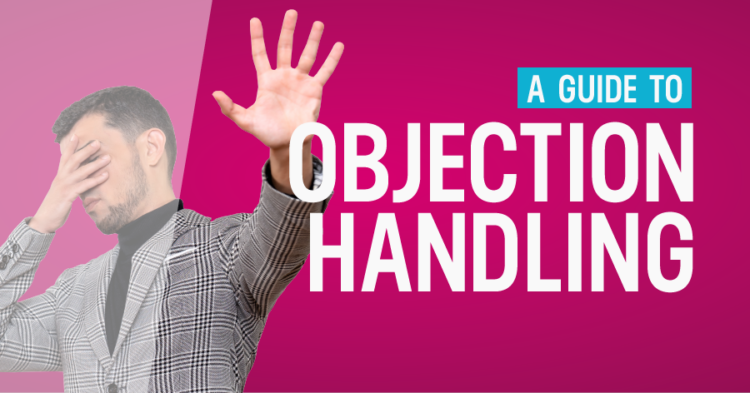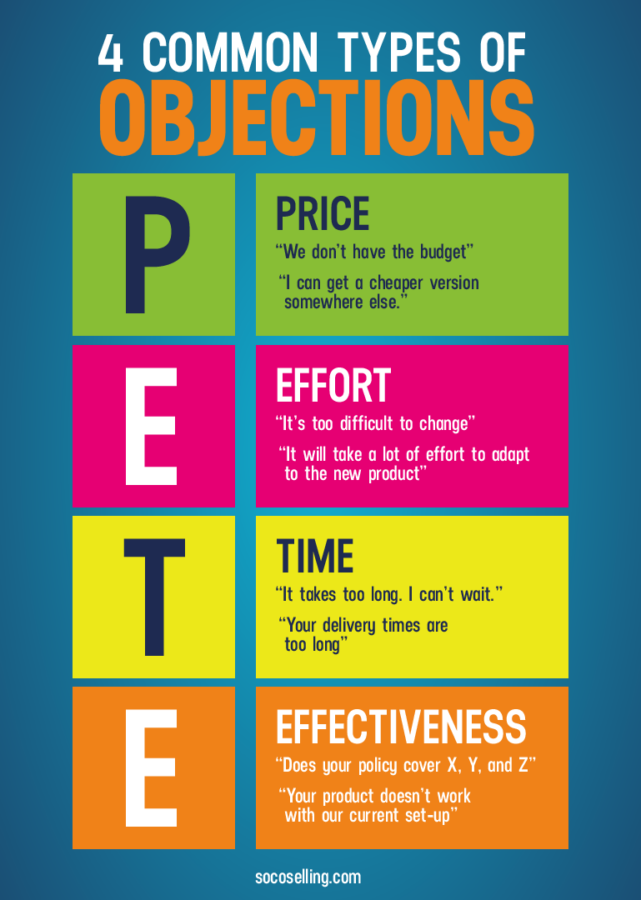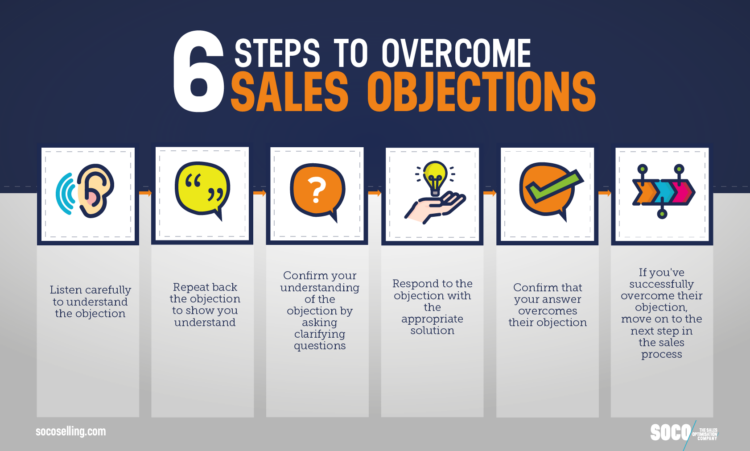
In a perfect world, prospects will be easy to qualify, move through the sales pipeline with ease and have absolutely no sales objections. Unfortunately, we don’t live in a perfect world. If prospects didn’t have objections, then they would’ve bought your product already! That’s why objection handling is just half the fun in sales, so keep reading to learn common sales objections and how to overcome them.
What is a Sales Objection?
A sales objection is a clear expression by a prospective buyer that they’re not yet satisfied enough to want to buy from you, meaning that more work must be done to remove the barrier stopping them from being happy.
Sales objections often occur when a potential customer raises an issue that prevents them from immediately making a purchase or moving forward with the sales conversation.
Why Is Objection Handling in Sales Important?
While objections may initially seem like awkward obstacles, they’re a natural part of the sales journey. They present valuable opportunities to address customer concerns, provide additional information, build trust, and demonstrate the value and benefits of your product or service.
Common Types of Objections in Sales
You might be saying to yourself, “There’s really only one kind of objection, and it’s always …” you guessed it: Price. Well, you’re not completely wrong there. Price is probably the most common objection that most of us hear. In fact, most of the time, your customer wants some kind of discount.
But, in our experience, there are actually four broad categories of objections called PETE: Price, Effort, Time, and Effectiveness.

Price Objection in Sales
Price is one of the most common objections and one of the most challenging because customers are always pushing back on price. They want to find out, “Can I get a discount?”
Here are some examples of the price objection:
- “It’s too expensive.”
- “We don’t have the budget”
- “I can get a cheaper version somewhere else.”
How to Overcome Sales Objections to Price
To handle the price objection, you need to find out if they can’t afford it (affordability) or if they don’t see the value. Does your prospect have the money? Can they afford it? Do they have the budget? If the answer is yes! Then, you need to start looking at how to demonstrate value and make sure that they see that this is the right solution for them. So, you address price objections that revolve around value by demonstrating the value, not by dropping the price.
If, on the other hand, they see the value, they think your product is worth it, but they just can’t afford it. You need to address the price objection by finding a way to make it easier for them to afford it. Can they pay monthly installments? Can they pay a deposit now and the rest later?
The next time you speak with a customer and they say, “Oh, that’s expensive.” Ask them, “When you say it’s expensive, or you say it’s too much, do you mean that it was more than you planned on spending?” (Affordability) “Or do you not see the value of that price, or do you’re not sure why it’s priced at that much?” The answer to that question will be very different and will then help steer you in the right direction regarding how you handle that price objection.
When faced with a price objection it’s important to ask your customers clarifying questions to identify which type of price objection you’re facing (Value or Affordability) to overcome this objection effectively.
Value Objections in Sales
- “It’s too expensive for what it does”
- “It’s not worth the price you’re selling it for”
How to Overcome Price Objections Relating to Value
To overcome an objection to value, you must understand that justifying value to your potential customer is a delicate balance between education and influence. You want to demonstrate value by focusing on the benefits. You aren’t selling a product or a service. You’re selling an outcome – a solution to their problem. Nowadays, every good sales rep sells solutions, so how is your solution better than the others? Value. Demonstrate them. Show them that you are providing more than just a solution but a companion who will show them the way. Instead of treating prospects as transactional customers, you must treat them as partners in a long-term selling relationship.
Affordability Objections in Sales
- “I don’t have enough budget.”
- “The price is more than I have allocated.”
- “I can’t afford it.”
How to Overcome Price Objections Relating to Affordability
If it’s an affordability issue, offer them options like payment terms. Pay a little bit now, pay later. Installment payments, for example. Or incremental commitments. For example, if it’s a large IT project, you could break it into different parts of the project and have the money come from different quarterly budgets, for example. Make it easy for them to afford it.
Effort Objections in Sales
Effort objections often come up when it’s easier for your prospect to stay with what they’re using now or they don’t see a strong enough reason to change how they’re doing something. This objection shows up in the form of the following statements:
- “It’s complicated.”
- “The product is a hassle.”
- “I prefer an easier option.”
- “It takes too much effort to switch”
- “I’m happy with what I’m doing now”
How to Overcome Effort Sales Objections
In sales, you have to realize that most of us are creatures of habit, and we really don’t like change. Even if it’s a change for the good, we still don’t like change. Thus, the effort objection is one of your biggest challenges and hurdles to overcome. How do you overcome this? By showing them how easy it actually is!
For instance, you can get them involved in your demonstration with hands-on experience and let them experience how easy it is to use or operate. If you’re still not receiving any enthusiasm, you can always rely on retelling similar situation stories. Stories from other customers who once had that same objection but realized it was easier than they thought.
Time Objections in Sales
In a world where customers can buy many products and services with a click of a button and have them delivered in 2 hours, the time objection is coming up more and more often. The Time Objection shows up in the following examples:
- “I don’t have the time.”
- “I need this delivered tomorrow.”
How to Overcome Sales Objections Around Time
To handle an objection about time, you need to clarify the timing issue with your potential client, for instance, “I hear what you’re saying, and it sounds like you need it within two weeks. Can you tell me more about that?”
As they talk to you, they may explain, “Well, we have a project that we’re launching in eight weeks, and we really want to make sure that we can have that product in stock soon.” This reflection sometimes uncovers other hidden needs or even reveals to the customer that timing isn’t really the issue – maybe it’s something else.
Now, if your prospective client says, “Look, we have an event coming up, and we need the product now.”
This is where you need to look at offering alternatives. Start considering another product or service that you could offer. For example, if you’re in furniture and they’re looking for one particular make or model or brand, but you don’t have it in stock, is there something else that you could offer them that’s similar that can fill that need now?
Effectiveness Objection in Sales
When prospects don’t think your solution will work for them, or they don’t have confidence in the effectiveness of your solution, that’s where the ‘Effectiveness Objection’ comes up. Here are examples of effectiveness objections:
- “I had a bad experience with similar products/services.”
- “You don’t understand my challenges. I need help with Y, not X.”
- “I don’t think it will do what I need it to do”
How to Overcome Sales Objections Around Effectiveness
Effectiveness is a huge sales objection and one of the most critical to get right when faced with one.
However, sales professionals aren’t always equipped to handle them because they’re uncommon. To understand how to handle an objection about effectiveness, let’s begin by explaining precisely what effectiveness means.
Your potential clients are likely thinking, will this product work? Will this solve our problems? Will this meet our needs and address our challenges? Even if you think you’re doing everything right. You can have the right price; the timing could be great, and the delivery could be same-day shipping. But they’re still not convinced it will work, “we’re just not a good fit,” they say.
Blow your potential clients’ effectiveness objection out of the picture by asking them to “tell me more about your concerns.” They’ll likely say, “Well, I’m not sure this will work.” Say, “Tell me more. What are you particularly concerned about? Tell me more about your system, infrastructure, and process.” Once they’ve answered, you need to demonstrate and propose how your solution will work for them, usually with the aid of proof devices.
Competitor Relationships – Bonus Objections in Sales
When your prospect is happy with the solution they’re using now, you may find yourself faced with the ‘Competitor Relationships Objection’. Here are some examples:
- I’m happy with [competitor].”
- “We’re doing fine in this area.”
- “I’m okay with the status quo.”
- “Competitor X says [false statement about your products].”
- “We only work with people we know.”
How to Overcome Sales Objections Relating to Competitor Relationships
You’ve likely heard the phrase, “We already work with your competitor.” For many, this usually results in abandoning the sale altogether in fear of not wanting to present the reasons why you’re more suitable in fear of being misconstrued as talking ill of your competitors’ range.
While yes it is a tricky process and one that you have to prepare for – it is entirely possible. The trick is to look for cracks in their working relationship, which likely hasn’t been reevaluated since they started working together.
Try asking questions like “Are there areas you wished your supplier did better?”, “Can your current solution do x?”, “Many people switched from X to us because they found that we actually do Y better. Can I show you how?”
How Do You Handle Sales Objections?
When it comes to overcoming objections, start by listing the common objections people have given you in the past and then write a short rationale for each objection.
Frame your response to each objection in a positive way and practice it.
Think of examples of clients who had the same objection, found a way to overcome it, and consequently benefited from using your products and services.
Remember, every sales objection is unique, and it’s essential to tailor your approach to each customer and situation. By following these steps and adapting them to specific objections, you can handle objections effectively and increase your chances of closing the sale.
1. Hone the Skills Needed for Objection Handling
As a salesperson, honing the skills to overcome sales objections is crucial for success. It directly impacts your ability to close deals and generate more revenue.
When you master the skills necessary for sales objection handling, you build stronger relationships with your customers by showing them that you understand their concerns and have an unwavering dedication to finding the best solutions.
With this said, let’s take a look at the skills you need to hone to achieve all of this and more:

Empathy
Empathy is an emotional intelligence skill. It’s defined as the ability to know what another person is thinking or feeling. Therefore, if you want to master objection handling, you must be able to walk in another person’s shoes. For example, “I’m sorry you feel that way. It sounds like this has been very frustrating!”, “I hear what you’re saying, and I think I can definitely help you.” By showing empathy for your customer’s problems, they are more likely to open up and share more.
Curiosity
Too many sales professionals think they must do all the talking when meeting prospects. What ends up happening is that they dominate the conversation, leaving little time for the prospect to share anything about themselves or what they’re looking for.
Instead, ask the prospect what they’re looking for and what they’ve tried before? What worked, what didn’t work? What is the outcome you’re trying to achieve? Then, listen intently instead of waiting for your chance to jump in and sell. Only once you have all of the information can you make an informed recommendation on what product or service is the best for them.
Rapport Building
As the saying goes, ‘People do business with people they know, like, and trust.’ So, of course, you need to build rapport – and quickly. One of the most effective ways to do this is to use your customer’s name and, probably more critically, know how to pronounce it! It helps you connect with them because they feel heard, and well, people love the sound of their names. However, make sure to use their name naturally in the conversation – otherwise, you’ll come off as indigenous.
2. Clarify the Objection
First, you must thoroughly understand and uncover all objections and related issues. You’ll frequently find that the real problem isn’t what the buyer tells you initially. Instead, it’s your responsibility to get to the root of the objection. So how do you do this? First, you must ask the buyer for permission to explore the issue further together.
Then, once you have thoroughly discussed the issue, you need to repeat it as you understand it to the customer. Again, it may seem counterintuitive, but by doing this, the buyer starts to see the overall issue – and can begin to identify any remaining related problems themselves.
Also read: Compiling a List of Frequently Asked Questions
3. Isolate the Objection
Sometimes, your prospect has multiple objections: the warranty is too short, the price is higher than your competitors, and I need it tomorrow, but your product takes 2 weeks.
When multiple objections arise, it’s important to find out their most important objection and focus on that. They might say the warranty is too short, but if you extend it, they still won’t buy it because they need it tomorrow. To overcome multiple objections, isolate the most pressing objections by asking clarifying questions: “I hear you say the warranty is too short. If we could make it longer, is that the main thing holding you back?” or “What is most important to you in making your buying decision: price, warranty or delivery?”
By asking these questions, you’ll avoid wasting time on an objection that won’t help you close the sale.
4. Respond Properly
Once you’re sure you’ve uncovered all objections with the buyer, you should seek to suggest a solution straight away. However, stay truthful and realistic, and don’t start offering solutions you can’t actually promise. Furthermore, long responses feel like a sales pitch. This is a two-way conversation, so keep your answers direct and to the point.
5. Confirm You’ve Satisfied the Objection
Last, you must check that you’ve satisfied their objection with your solution. Trust me, just because the customer nodded to your responses doesn’t mean they entirely agreed; instead, they’re polite. So, ask if they’re happy to continue with your solution and explain other components if necessary.
6. Know When to Walk Away
After you go through everything, hard qualifying, value demonstration, and if they still don’t “get it”, stop fighting. Stop pushing. And move on. Find another customer who gets it! Those who love what you’re doing are willing to invest because they see the return on investment.
Accelerate your sales career and master assessing the needs of customers
Sales skills need to be learned, practiced, and mastered. In our Sales Accelerator pack, we teach you the skills all sales professionals, entrepreneurs, and small business owners need to sell effectively. Join us in mastering the sales process, starting with getting the right mindset, differentiating from the competition, building strong relationships, and delivering compelling sales presentations using stories.


